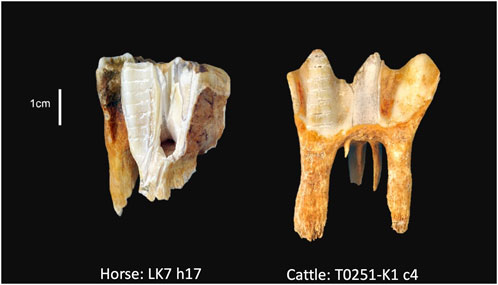- 1Key Laboratory of Cenozoic Geology and Environment, Institute of Geology and Geophysics, Chinese Academy of Sciences (CAS), Beijing, China
- 2CAS Center for Excellence in Life and Paleoenvironment, Beijing, China
- 3State Key Laboratory of Loess and Quaternary Geology, Institute of Earth Environment, Chinese Academy of Sciences, Xi’an, China
- 4CAS Center for Excellence in Quaternary Science and Global Change, Xi’an, China
- 5Institute of Archaeology, Chinese Academy of Social Sciences, Beijing, China
- 6Shaanxi Provincial Institute of Archaeology, Xi’an, China
A newly excavated ritual site, Xuechi, exposed abundant sacrificial livestock, allowing to understand the supplies and managements of livestock during the early Chinese Qin-Han Empires. Here we reported animal enamel 87Sr/86Sr values from the Xuechi site that are obviously higher than those of local snails and surface water, as well as calcites of the Chinese Loess Plateau (CLP) where the site was located, strongly suggesting that these sacrificial animals were not raised in the vicinity of the site. The regional bioavailable 87Sr/86Sr isoscape further indicates that some livestock were probably derived more than one hundred kilometers away, suggesting a complex social network for recruiting and managing the sacrificial activities. In the context of other Neolithic-Bronze Age records on the CLP, an increasing trend in variation of faunal 87Sr/86Sr values shows a robust correlation to Chinese states’ trajectory, in concordance with the territorial expansion model for state formation.
Introduction
Characterized by its large scale and diverse people, the Qin-Han dynasties essentially reconfigured Chinese literary and religious practices, kinship structure, and civil life, and fundamentally reshaped the cultural landscape which formulated Chinese traditions and influenced the contemporary world (Lewis, 2010). Before an empire, as a state of the Zhou dynasty, the Qin’s conquests of its rivals and the unified empire were achieved on a foundation of reforms that Shang Yang carried out in the mid-4th century BCE (Twitchett et al., 1986; Lewis, 2010; Wang, 2017). Shang Yang’s systematical reform greatly stimulated Qin’s agricultural production and consequently organized the state for war. In a book reputedly authored by Shang Yang, Dukes of Qin were asked to get insight into thirteen actual figures, including numbers of horses and cattle, the volumes of forage, and numbers of granary and coffer (Shi and Dong, 2002). It was evident that horses and cattle contributed significantly to both agriculture and war.
The united Empire Qin created a new title for the highest ruler, huangdi 皇帝. Huang皇 means “splendid” and was used as an epithet of heaven, while di帝 indicates a high god taken over from earlier dynasties. In claiming the title huangdi for himself, the emperor of the empire declared his superhuman power and strengthened the communication with the highest god through various approaches (Lewis, 2010). Among them, rich sacrifice to the gods was commonly adopted.
During the communication with the gods, sacrificial offerings, such as cattle and horses, were extensively consumed. Their remains bear valuable details about livestock supply, economic network, and even social structure, most of which are beyond the historical document (Huang, 1984; Yuan and Flad, 2005; Campbell, 2009). During 2016-2020 excavation seasons, Chinese archaeologists have excavated a ritual site from Fengxiang County, Shaanxi Province (Figure 1A). This site, named Xuechi血池, is about 12 km northwest of the Yongcheng ruins, the Qin State’s capital between 677 and 350 BCE (Tian and Zhang, 2003). The excavation focused on a rammed earth platform and sacrificial pits. It unearthed more than 3000 relics, mainly including jade artifacts, bronze chariots, and livestock, which were often used for sacrificial offerings. Based on these unearthed antiquities, as well as comparisons to the historical documents, this site has been identified as the formal venue for national sacrifices to heaven, led by the kings and the emperors from the Qin State to the Han Dynasty.
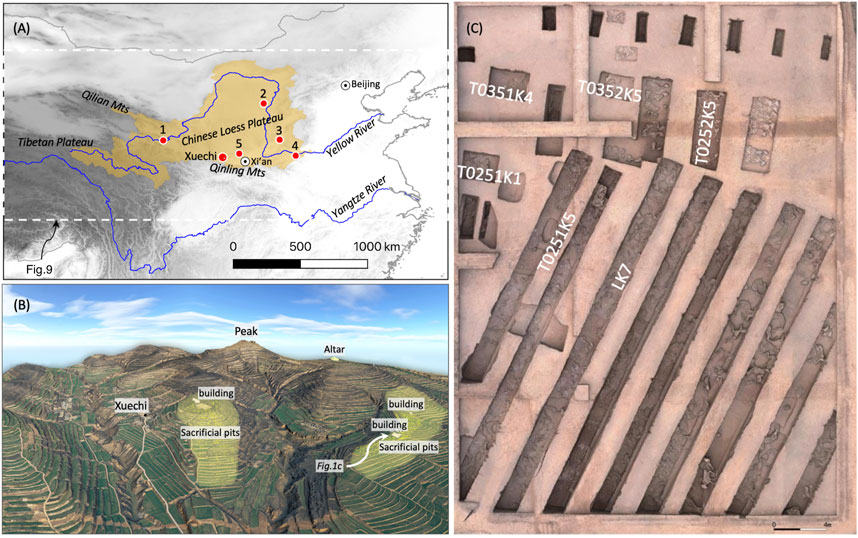
FIGURE 1. The context of Xuechi Site. (A) Location of the Xuechi site, and comparable sites mentioned in text. 1 Lajia; 2 Shimao; 3 Taosi; 4 Er’litou; 5 Zaoshugounao; (B) Landscape of the Xuechi site. The yellow shading areas indicate the sacrificial pits confirmed by extensive drillings; (C) The excavation square with the sampled sacrificial pits marked.
This ritual site is named after the nearby village of Xuechi (Figure 1B), which means a blood pool in Chinese. It is said by the locals that Xuechi is an ancient name for the location, generally related to slaughter and bury livestock for sacrifice. A wider archaeological survey for the surrounding area of 4.7 million square meters has confirmed more than 3,200 related remains, including buildings, facilities, roads, and sacrificial pits (Figure 1B). Recent excavations of 5000 square meters exposed 387 sacrificial pits in various dimensions, 2557 sets of archaeological remains. Besides, more than 245 sacrificial animals, including at least 204 horses and 32 cattle, commingled or intact, were found. Because of their great importance in transport, trade, and warfare, the extensive consumptions of these sacrifice animals demonstrate the high level of the ritual site and raise questions on the livestock: their provenances, the management system, selecting criteria for sacrificial animals, and so on. Unlike the detailed records about livestock management during the Qin-Han Empires (Chen, 2015), their origins are still challenging to historians and archaeologists.
The geographical origin of livestock can be tracked by strontium (Sr) isotopes in their tooth enamel (Bendrey et al., 2008; Minniti et al., 2014). Variation in strontium isotopic compositions, conventionally expressed as 87Sr/86Sr, follows the geological age and lithology of bedrocks. Strontium is transported from weathering bedrocks, soils, and waters into the food chain and partly substitutes calcium in local animal skeleton. The 87Sr/86Sr value in archaeological fauna tooth enamel retains the signatures of the mixed geologic source materials. It thus serves as an averaged geographic signature from childhood when the tooth was forming. This study aims to investigate Sr isotopic compositions of animal teeth from the sacrificial pits of Xuechi site and constrain the likely geographical origin of the livestock.
Materials and methods
Archaeological excavations
The former capital of Qin State, Yongcheng ruins in Fengxiang County, has been extensively investigated over the past 50 years. After a thorough investigation in the middle 1980s, Xuechi site was noticed by archaeological community and tentatively connected to the Yongcheng ruins as a state sacrificial venue. During 2016-2020, a large-scale excavation at Xuechi demonstrated its function and age. The 124 recovered jade artefacts are dominated by groups consisting of jade figurines, huáng 璜 semicircle pendants, and cóng 琮 vessel. The jade figurines’ dimension and style (Figure 2) are close to those from the previously excavated Luantingshan Site (Joint Archaeological Team for Early Qin Culture, 2005), which seem to be exclusively designed for imperial ritual activities. Some ceramics bear inscriptions of Chinese characters, like Upper Zhi 上畤 and Lower Ci 下祠 (Figure 3), clearly linking Xuechi Site to imperial sacrificial sites. Judging by the style of the sacrificial remains, the site was primarily assigned to a high-level sacrificial site into the interval from the Qin State during the Warring States to the unified Han Empire, which succeeded the Qin Empire. Furthermore, bronze coins from Xuechi Site added independent chronological constraints. The first unified currency in China, the Ban Liang (Figure 4A), was issued in the Qin Empire around 210 BC, and its succeeding coin, the Wu Zhu (Figure 4B), was cast in the Han Empire since 118 BC. These dates are firmly consistent with the radiocarbon dates for 14 livestock from 13 pits, including ten horses, three cattle, and one ovicaprid (Supplementary Tables S2, S3). A single-phase Bayesian model with a uniform prior generated in Oxcal provides a modeled start date for Xuechi of between 567 and 267 BCE (95.4% probability) and an end date of between 17 and 238 CE (95.4% probability), yielding the estimated span between 340 and 573 years (2σ calibrate range).
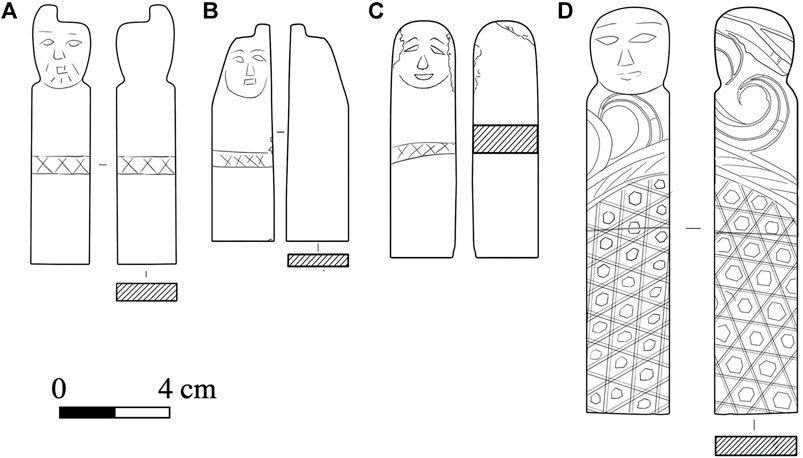
FIGURE 2. Jade figurines from Xuechi Site. Male: (A) T6907K24:22; (B) T6807K2:3; Female: (C) T7306K3:8; (D) T7006K11:2.
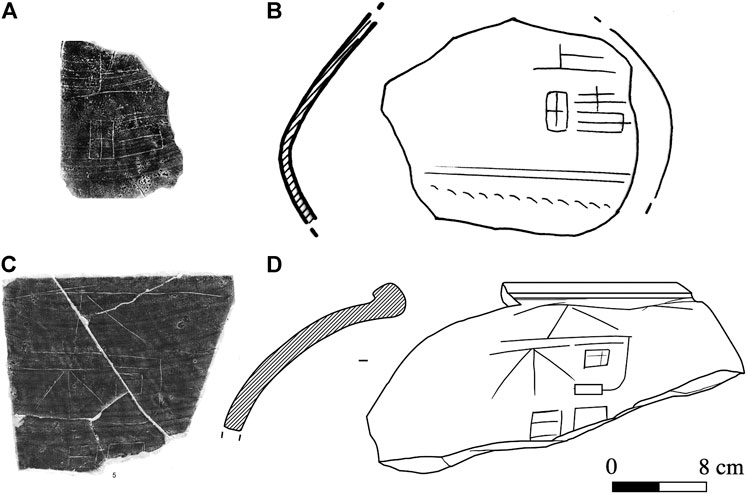
FIGURE 3. Ceramic fragments from Xuechi Site. Upper: T7107K1:3, ceramics with inscriptions of Upper Zhi 上畤 (A) rubbing, (B) line drawing; Lower: T0151②:8, ceramics with inscriptions of Lower Zhi 下祠 (C) rubbing, (D) line drawing.
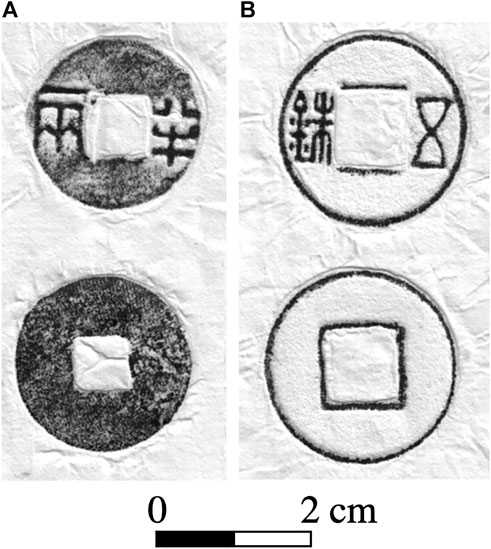
FIGURE 4. Coins from Xuechi Site. (A) Rubbings of a Ban Liang coin (AIIIT7107K1:4). The Ban Liang coin was the first unified currency of the Chinese empire, introduced by the first emperor Qin Shi Huang around 210 BC; (B) Rubbings of a Wu Zhu coin (AIIIT7008K3:35). This kind of coin was first cast from the Han Dynasty in 118 BC.
Samples
In the 2017 archaeological season, the 1,200 square meters excavation (Figure 1C) exposed 33 sacrificial pits. Among these pits, 30 pits contain considerable amounts of sacrificial livestock (Figure 5 for details). Fourteen livestock individuals were randomly picked up for radiocarbon dating. We collected tooth specimens from 29 individuals, including ten cattle and nineteen horses (Supplementary Table S1) for the first round. After completing the above measurements, we conducted a second-round sampling on the four most likely outliers to investigate their intra-teeth 87Sr/86Sr variations. Sampling took place along the enamel profile, starting from tooth cervix and advancing toward the apex, yielding seven samples each in near-evenly spaced intervals (Figure 6). This sampling strategy allowed to evaluate the isotopic signals from an individual and constrain the relative range where the tooth formed with a higher temporal resolution.
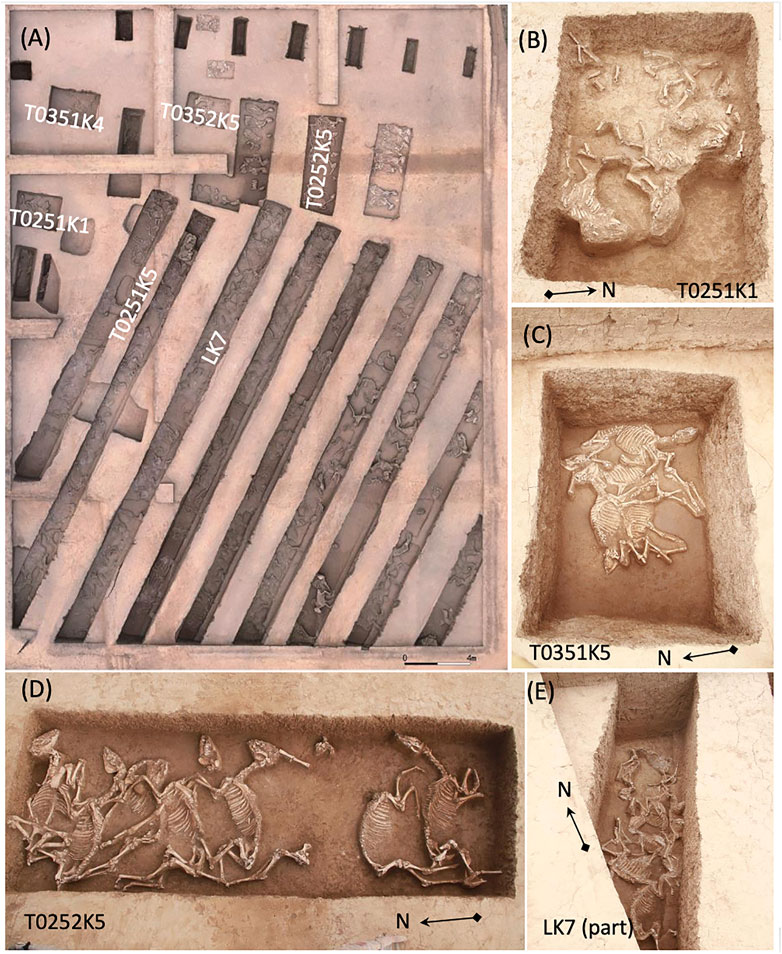
FIGURE 5. The excavation squares. (A) The excavated and sampled sacrificial pits. (B–E) Details of the sampled pits which contributed multiple individuals of livestock.
Strontium isotope analysis
About 10 mg of the enamel powder was drilled along the tooth growth axis from the cusp to the enamel-root junction using a diamond-tipped Dremel tool. Then the samples were soaked in 5% weak acetic acid for one hour to remove diagenetic carbonate. Each sample was washed using deionized water for three times, dried and dissolved in 0.2 N HCl. The supernatant was dried down and then redissolved in 2.5 N HCl for Sr separation chemistry. For river water samples, after centrifuging the sample, approximately 5 ml of supernatant was dried on a hotplate at 100 °C. All samples were dissolved in 2.5 N HCl. The strontium was separated from the matrix using AG50W × 12 cation-exchange resin (200–400 mesh). Isotopic ratio measurements were using a Triton Plus thermal ionization mass spectrometer (TIMS) (Thermo Fisher Scientific) housed at the Institute of Geology and Geophysics, CAS, using an 88Sr/86Sr ratio of 8.375,209 to correct for mass fractionation. All 87Sr/86Sr ratios were normalized to a value of 0.710,250 for the NBS-987 standard with the reproducibility of 0.710,268 ± 0.000013 (2σ, n = 5) during this work.
Statistical analysis
To compare the 87Sr/86Sr data from various site, we also present these data normalized to maximize the visibility of group patterns (Supplementary Table S5). This is conducted by normalizing the 87Sr/86Sr value, Sj;i for each animal individual j from site i, by subtracting mean 87Sr/86Sr value at the site, Mi, and dividing by the local range at the site, Ri. We refer to the normalized 87Sr/86Sr value for individual j as Zj:
Results
Isotope results were wide-ranging (Figure 7; Supplementary Table S3). 87Sr/86Sr values of 32 faunal samples ranged from 0.71051 to 0.71321, covering most riverine 87Sr/86Sr values in north China (Wang and Tang, 2020). The most radiogenic value was observed in a cattle tooth from the pit T0251K1 (individual c4), and the lowest value is from a snail shell found in the pit LK7 (individual s1). The range of snail samples from the pit LK7 was more restricted (0.71051–0.71063), coincident with those from the nearby riverine samples (Figure 7). The consistency between snails and riverine water samples made them possible to estimate the local range of bioavailable 87Sr/86Sr values for Xuechi Site.
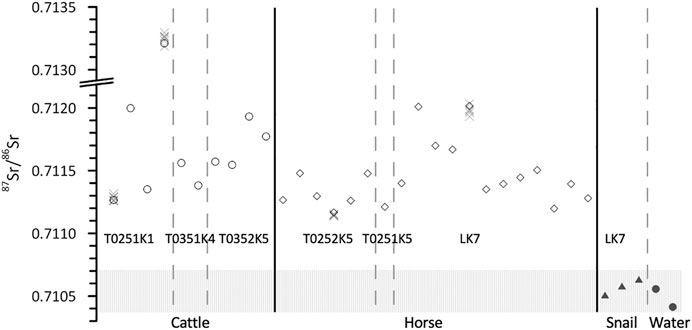
FIGURE 7. Strontium isotope (87Sr/86Sr) results from Xuechi site. Results are arranged by pits where the samples were collected. Open circles and diamonds represent cattle and horses, respectively, and the crosses behind the individual are the measurements of its sequential samples. Shaded triangles and circles indicate snails and water samples, and the shaded area represents the estimated “local” 87Sr/86Sr range based on the shaded samples.
The results of sequential samples well enveloped the observed 87Sr/86Sr value of the correspondent individual and exhibited quite narrow ranges in each sampled individual. The greatest range of sequentially sampled individual (T0251K1-c4) was still less than 0.00011, even significantly lower than the variability of the snail and water samples (Figure 7) and therefore strongly suggest a constricted provenance for these individuals.
Although the variances are statistically equal (p = 0.073), as a whole, cattle have higher 87Sr/86Sr mean values than horses by a t-test (p = 0.047). If we remove the outlier of T0251K1-c4, no significant differences can be observed between their means (t-test, p = 0.150), as well as their variances (F test, p = 0.737). Furthermore, the 87Sr/86Sr values of enamel were diverse across all pits. Cattle within the pit T0251K1 range from 0.711,266 to 0.713,210 (0.7120 ± 0.0009, n = 4), and those within the pit T0352K5 span from 0.711,544 to 0.711,930 (0.7117 ± 0.0002, n = 4). However, the inter-pit differences are not statistically significant between the cattle groups (t-test, p = 0.05). Again, similar variances and means of 87Sr/86Sr values can be observed in the horse enamels from the pits T0252K5 and LK7, although the samples from LK7 have a slightly greater range and variance.
Discussion
Defining the “local range"
The Xuechi site is located on a slope near a mountain top that would not be expected to raise the livestock. On the regional scale, the widely distributed eolian loess is an excellent estimator for the average composition of the upper continental crust (Jahn et al., 2001). Thus, similar geochemical signals could be expected. The silicate fraction of the eolian deposits showed highly radiogenic characters with 87Sr/86Sr values greater than 0.7150 (Supplementary Table S4, Figure 8A; Bird et al., 2020; Chen et al., 2001; Sun, 2005), distinct from the accompanied calcite fraction, which has 87Sr/86Sr values generally lower than 0.7115(Yang et al., 2000; Rao et al., 2008). Due to their differential erosion rate, an isoscape of the strontium composition of China based on the riverine water samples is more inclined to the values of the calcites (Wang and Tang, 2020). Here we use the snails and the riverine samples to estimate the “locality range”, yielding a ± 2σ interval of 0.71037-0.71070. It well falls into the 87Sr/86Sr range of loess calcites (Supplementary Table S4, Figure 8B), as well as the riverine water samples (Wang and Tang, 2020).
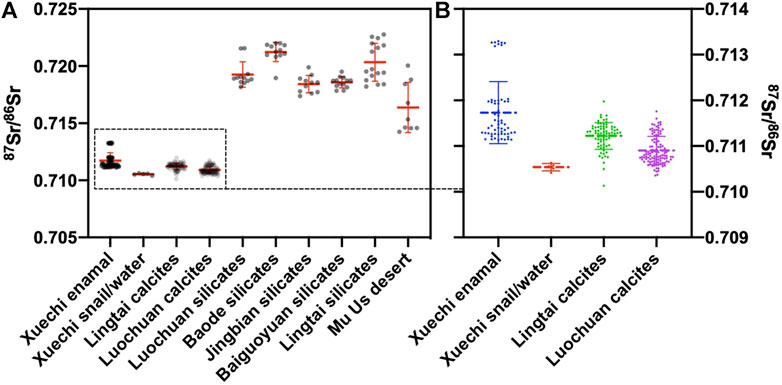
FIGURE 8. Local 87Sr/86Sr variability of Xuechi site. (A) 87Sr/86Sr in various agents from the Chinese Loess Plateau; (B) Comparison of 87Sr/86Sr from between animal enamel from Xuechi and calcites in Quaternary loess.
At the study site, the eolian loess coverage extends for at least 100 km in all directions and more than 500 km in the west and north. Inferred from archaeological swine, the “local” 87Sr/86Sr ranges for the sites on the Chinese Loess Plateau (CLP) are essentially comparable. Specifically, the Taosi Site on the eastern CLP had a local range of 0.71104- 0.71131 (Zhao et al., 2011), the Lajia Site on the western CLP had a range of 0.71080–0.71106 (Zhao et al., 2018), and the Shimao Site had a range of 0.71107–0.71130 (Zhao et al., 2016). Although distorted by the nearby highly radiogenic mountains, the sites of Erlitou had a higher average 87Sr/86Sr value but a similar interval for local ranges.
The Xuechi livestock exhibit significantly higher 87Sr/86Sr values than the CLP sites. We here conservatively regard the 12 individuals with strontium isotope ratios above 0.7115 as “nonlocal”. These “nonlocal” individuals with higher 87Sr/86Sr values (>0.7115) point to a region with considerably older and more radiogenic lithologies, instead of the nearby Chinese Loess Plateau, although it stretches for at least 100 km in all directions from the Xuechi site.
From the bioavailable 87Sr/86Sr isoscape in China (Wang and Tang, 2020), as well as the geological background, the nearest possible origins include the eastern Qinling Mountains in the south and the Qilian Mountains in the northwest. All these possible origins are at least 150 km away from the site. The sequential sampling data of the extreme outliers provided better constraints on their possible places of origin using Bayesian modeling method (Wang et al., 2021). For instance, the cattle T0251K1-c4 with the 87Sr/86Sr ratio of 0.713,250 ± 0.000034 (n = 7) might be collected from the eastern Qinling Mountains and the Qilian Mountains, as well as the southern Western Qinling Mountains, further supporting the links of these regions to the site. Meanwhile, the similarity index hints that the horse (LK7-h17) with the 87Sr/86Sr ratio of 0.711,978 ± 0.000031 (n = 7) was likely from the most parts across the north China (Figure 9).

FIGURE 9. Probability density map on the possible geographical origins. The extreme outlied 87Sr/86Sr ratios observed at Xuechi livestock, (A) cattle T0251K1-c4 and (B) horse LK7-h17. Color bars mean that the high possibility likelihood is in red and the low possible likelihood is in grayey blue.
The livestock’s various origins are entirely consistent with independent historical (Chen, 2015) and genetic (Wen et al., 2020) evidence concerning the Qin-Han Empires. Ancient mitochondrial DNA (mtDNA) analysis of the horse remains from the pit LK7 revealed an extremely high mtDNA diversity. Placing the shared haplotype analysis in historical context, haplogroups F2 and B2 in Xuechi site displayed the highest frequencies in horses from NW China, haplogroups A1, C2, E, and F1, showed frequencies peaks in Mongolian horses, and haplogroup E might link to the Central Asia (Wen et al., 2020). This data likely demonstrated several distinctive maternal lineages for Xuechi horses from vast Eurasian steppe area (Jansen et al., 2002; Ma et al., 2018).
Horse bone stable isotopic analysis also reconstructed the various food sources of animals: mainly from millets, or from wild grass, and some of the ingested a large number of leguminous plants (Supplementary Figure S2). The variety in food structure among the horses demonstrated that they might have been recruited from various pastors across the empire (Chen et al., 2020), providing supports for our arguments presented above. Furthermore, ribs displayed a significantly higher δ13C than other bones of the same horse individual (n=9, paired-samples t test, p = 0.01). Given higher remodeling rate of ribs, these horses might consume a large amount C4 fodders before they were sacrificed. This was precisely consistent with the records in Zhou Li 周禮 that sacrificial animals would be intensively foddered for three months different from common herds before being slaughtered.
Variation of livestock 87Sr/86Sr values linked to expanding provenances
The variation of livestock 87Sr/86Sr values depends on the heterogeneity of geology where the livestock raised and, in general, is proportional to the range of livestock provenances. The study site Xuechi is located on the Loess Plateau, where the geological background is quite similar (Gallet et al., 1996; Jahn et al., 2001) and Chinese early civilizations gradually developed since the Late Neolithic period (Liu and Chen, 2012). To compare the 87Sr/86Sr values from different sites on the CLP, the raw data was normalized to the distance of each individual’s value from the site mean in units of local range. We therefore can pool all sites together to examine the variance pattern among the sites chronologically (Figure 4).
The six sites showed increasing variations on the CLP and could be classified into three distinct groups (Figure 10, Supplementary Table S5). The first group contains the Lajia and Shimao sites, ca. 4000-year-old (Zhang et al., 2014; Jaang et al., 2018). The normalized 87Sr/86Sr values of these two sites are mostly clustered with rare outliers that occurred, implying a concentrated livestock population with sparse individuals from long-distance exchanges. The second group, including the sites of Taosi (He, 2016) and Erlitou (Zhang et al., 2008), as well as Zaoshugounao (1,400–900 BCE, Li et al., 2020), shows similar but more variable 87Sr/86Sr signatures. For example, the variance in normalized 87Sr/86Sr is significantly larger for Erlitou (n = 21) than for Shimao (n = 18) by an F test (p < 0.001). The study Xuechi site falls into the third group alone for its most variable 87Sr/86Sr signatures. The variance in normalized 87Sr/86Sr for Xuechi (n = 29) is significantly larger than that for Erlitou, by an F test (p < 0.001), suggesting a higher migratory livestock population at Xuechi than ever before.
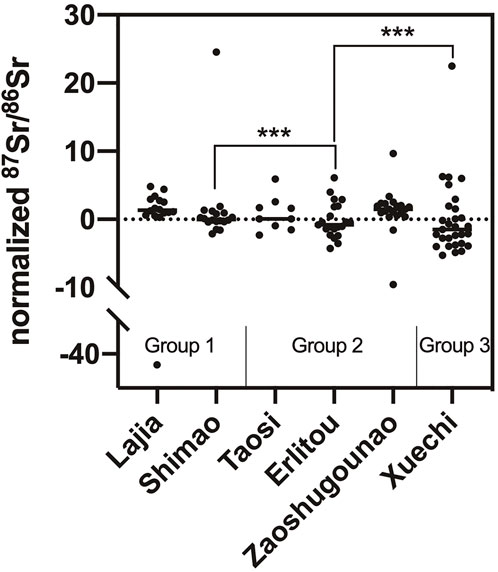
FIGURE 10. Comparison of normalized 87Sr/86Sr values in faunal enamel from the sites on the loess area in the North China. These sites were grouped based on their similarity of faunal 87Sr/86Sr distribution, and the asterisks between groups show the significant differences at the level of 0.001.
All these data presented above are collected from the key archeological sites on the loess area (Figure 1), where the earliest states and empires emerged subsequently. Chronologically, the Lajia and Shimao are regional cultural centers along the Yellow River. At this stage of competing chiefdoms (Liu and Chen, 2012), social complexity has been observed from more levels of settlement hierarchy and the existence of public ritual areas along the Yellow River (Liu and Chen, 2012; He, 2016; Jaang et al., 2018), even being proposed as a precursor of states (Liu and Chen, 2012).
Almost meanwhile, the Taosi and Erlitou sites from the lower reach of the Yellow River Basin demonstrated a tiered hierarchy of settlements, differently ranked graves and administrators (Liu, 2005). The slightly younger Er’litou culture further involved rapid colonization to the surrounding regions, with particular interests in procuring vital resources, including timber, copper, tin, and salt (Liu, 2005). Moreover, Erlitou could disperse its political order to its periphery regions, as Yazhang (Tung and Wang, 2015) revealed, indicating political-economic domination over a region that was much larger than that of any Neolithic polities, including Lajia and Shimao sites. According to Liu and Chen’s estimation (Liu and Chen, 2003) Figure 11), more than 200 sites containing Erlitou material assemblages covered an area of ∼50,000 km2. This coverage might be similar to the later Zaoshugounao Site (1,400–900 BCE; Li et al., 2020), suggested by the normalized 87Sr/86Sr mentioned above, and is comparable to the major states in the middle-lower Yellow River around 350 BCE (Supplementary Table S6).
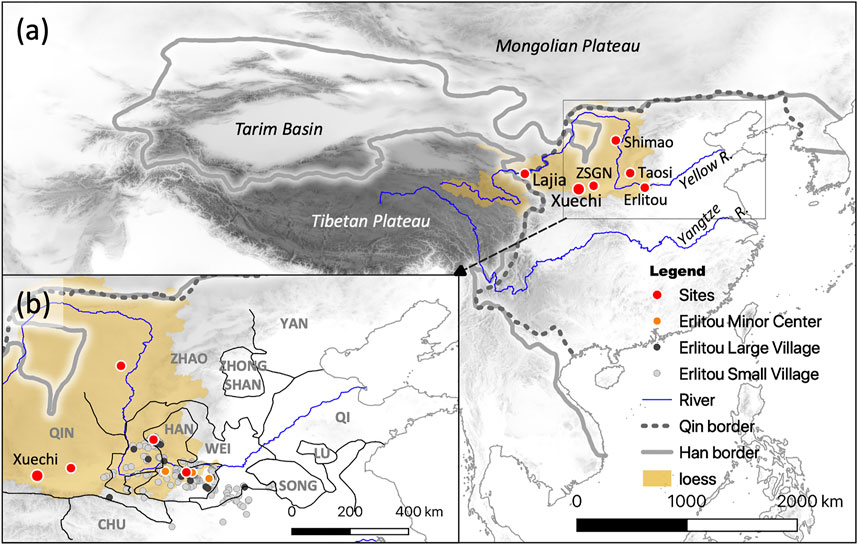
FIGURE 11. Historical contexts of the early Chinese states. (A) The comparable sites mentioned in the text and the boundary of Qin-Han Empires (ca. 210 BCE); (B) the distribution of Erlitou sites overlapped on the territorial borders of main kingdoms during the Warring States periods (ca. 350 BCE). The borders were redrawn after The Historical Atlas of China.
When the Qin Empire finally unified the previous states in the late third century BCE, its territorial area took an order-of-magnitude increase, reaching 3.4 million km2 (∼210 BCE). When the Han Empire established the Silk Roads to the Tarim Basin in northwest China (Richthofen, 1877) and invested a lot to develop southwest China, its territorial area (∼8 BCE) further achieved to 5.6 million km2 (Tan, 1991). The study site, Xuechi, was the highest ritual center for the Qin-Han Empire; its unprecedented variation indicated a broader provenance of livestock ever than before. The Qin Empire, firstly consisting of both north and south China, created a structured political system and standardized currency, weights, measures, and writings (Twitchett et al., 1986; Lewis, 2010). The central government thus first gained direct and effective controls over the imperial resources, definitely including livestock. The Han Empire fully followed Qin’s constitutions and further pushed for Confucianism in ideology suppressing other schools (Tan, 1991; Wang, 2017). Based on centralized and specialized administrators, all these efforts fortified society’s organizing and contributed to the transportation networks of resources.
This chronological pattern is consistent with the territorial-expansion model of primary state formation, which is in accordance with intensively independent archaeological evidence and historical archives mentioned above. The territorial expansion is an essential process during state formation, from the primary stage to the imperial phase. Spencer (Spencer, 1998, 2010) defined such long-distance expansion not only demanded the bureaucratization of central authority but also provided the resources necessary to the administrative transformation. From chiefdoms to states, and finally to empire, a clear increasing trend can be observed in the variation of normalized faunal 87Sr/86Sr value in Chinese loess region; moreover, each stage shift is coincident to a significant increase of the variation. Bioavailable 87Sr/86Sr values resultantly track the building of the first Chinese Empires, i.e., greater variation corresponds to a broader territory and higher social administration level. It is reasonable that the building of a state increases geological heterogeneity, imprinted in the variation of bioavailable 87Sr/86Sr values.
The data provides the very first investigation concerning supply patterns to the Qin-Han imperial ritual site: some analyzed cattle or horses were suggested to originate from the pastures hundreds of kilometers away.
Although the analyzed sample size cannot be regarded fully representative for the livestock in Xuechi Site, no individuals from the immediate locality are significantly new information, which implied a decentralized supply chain and a well-organized management system. In a broader context of Chinese archaeology, the increases in livestock 87Sr/86Sr variations significantly agree to the stages of state formation, possibly track the expansion of potential provenances.
Admittedly, these data just represent an inadequate attempt at this topic; further research using samples from comparable contexts is essential to provide a more meaningful scenario of the building of the Chinese Empire. The hints observed in bioavailable 87Sr/86Sr values are a promising perspective to the studies of territorial expansion and, therefore, state formation.
Data availability statement
The original contributions presented in the study are included in the article/Supplementary Materials, further inquiries can be directed to the corresponding author.
Author contributions
Conceptualization: ZT and JY. Methodology: ZT and XW. Investigation: XW, JX, XC, SH, MY, and YT. Data processing and quality control: XW and ZT. Writing—original draft: ZT and XW. Writing—review & editing: JX, XC, YT, and JY.
Funding
This work was funded by the Chinese Academy of Sciences (Grants Nos. XDA19050104, XDB26020401, and IGGCAS-201905) and the National Natural Science Foundation of China (Grant No. 42072210).
Acknowledgments
The authors are grateful to Dr. Yang Shiling, Chang Huaiying, Li Zhipeng, Yue Jian, Wen Shaoqing for helpful discussion, and Li Chaofeng and LI Youlian of IGGCAS for laboratory assistances.
Conflict of interest
The authors declare that the research was conducted in the absence of any commercial or financial relationships that could be construed as a potential conflict of interest.
Publisher’s note
All claims expressed in this article are solely those of the authors and do not necessarily represent those of their affiliated organizations, or those of the publisher, the editors and the reviewers. Any product that may be evaluated in this article, or claim that may be made by its manufacturer, is not guaranteed or endorsed by the publisher.
Supplementary material
The Supplementary Material for this article can be found online at: https://www.frontiersin.org/articles/10.3389/feart.2022.971004/full#supplementary-material
References
Bendrey, R., Hayes, T. E., and Palmer, M. (2008). Patterns of iron age horse supply: An analysis of strontium isotope ratios in teeth. Archaeometry 51, 140–150. doi:10.1111/j.1475-4754.2008.00419.x
Bird, A., Millar, I., Rodenburg, T., Stevens, T., Rittner, M., Vermeesch, P., et al. (2020). A constant Chinese Loess Plateau dust source since the late Miocene. Quat. Sci. Rev. 227, 106042. doi:10.1016/j.quascirev.2019.106042
Campbell, R. B. (2009). Toward a networks and boundaries approach to early complex polities: The late Shang case. Curr. Anthropol. 50, 821–848. doi:10.1086/648398
Chen, J., An, Z., Liu, L., Ji, J., Yang, J., and Chen, Y. (2001). Variations in chemical compositions of the eolian dust in Chinese Loess Plateau over the past 2.5 Ma and chemical weathering in the Asian inland. Sci. China Ser. D-Earth. Sci. 44, 403–413. doi:10.1007/bf02909779
Chen, N. (2015). A study of horsy policy in the Qin and han dynasties. Beijing: China Social Sciences Press.
Chen, X., Yuan, J., Yang, M., Chen, A., Yang, M., Zuo, H., et al. (2020). Feeding practice of horse offerings from the Beidoufan locality, Xuechi site. Archaeol. Cult. Relics 41 (6), 109–114.
Gallet, S., Jahn, B.-m., and Torii, M. (1996). Geochemical characterization of the Luochuan loess-paleosol sequence, China, and paleoclimatic implications. Chem. Geol. 133, 67–88. doi:10.1016/S0009-2541(96)00070-8
He, N. (2016). Taosi: An archaeological example of urbanization as a political center in prehistoric China. Archaeol. Res. Asia 14, 20–32. doi:10.1016/j.ara.2017.03.001
Huang, L. (1984). A review of sacrifice during Qin and Han dynasties (Philosophy and Social Sciences Edition). J. Northwest Univ., 48–56.
Jaang, L., Sun, Z., Shao, J., and Li, M. (2018). When peripheries were centres: A preliminary study of the shimao-centred polity in the loess highland, China. Antiquity 92, 1008–1022. doi:10.15184/aqy.2018.31
Jahn, B.-m., Gallet, S., and Han, J. (2001). Geochemistry of the xining, xifeng and jixian sections, Loess Plateau of China: Eolian dust provenance and paleosol evolution during the last 140 ka. Chem. Geol. 178, 71–94. doi:10.1016/S0009-2541(00)00430-7
Jansen, T., Forster, P., Levine, M. A., Oelke, H., Hurles, M., Renfrew, C., et al. (2002). Mitochondrial DNA and the origins of the domestic horse. Proc. Natl. Acad. Sci. U. S. A. 99, 10905–10910. doi:10.1073/pnas.152330099
Joint Archaeological Team for Early Qin Culture (2005). Main gains from the 2004 excavation of Luantingshan site in Lixian county, gansu. J. Natl. Mus. China 5, 4–14.
Li, Y., Zhang, C., Wang, Z., Dou, H., Liu, H., Hou, F., et al. (2020). Animal use in the late second millennium BCE in northern China: Evidence from Zaoshugounao and Zaolinhetan in the Jing River valley. Int. J. Osteoarchaeol. 30, 318–329. doi:10.1002/oa.2860
Liu, L., and Chen, X. (2012). The archaeology of China: From the late paleolithic to the early bronze age. Cambridge: Cambridge University Press.
Liu, L. (2005). The Chinese Neolithic: Trajectories to Early States. Cambridge: Cambridge University Press.
Ma, H., Wu, Y., Xiang, H., Yang, Y., Wang, M., Zhao, C., et al. (2018). Some maternal lineages of domestic horses may have origins in East Asia revealed with further evidence of mitochondrial genomes and HVR-1 sequences. PeerJ 6, e4896. doi:10.7717/peerj.4896
Minniti, C., Valenzuela-Lamas, S., Evans, J., and Albarella, U. (2014). Widening the market. Strontium isotope analysis on cattle teeth from Owslebury (Hampshire, UK) highlights changes in livestock supply between the Iron Age and the Roman period. J. Archaeol. Sci. 42, 305–314. doi:10.1016/j.jas.2013.10.008
Rao, W., Chen, J., Yang, J., Ji, J., Zhang, G., and Chen, J. (2008). Strontium isotopic and elemental characteristics of calcites in the eolian dust profile of the Chinese Loess Plateau during the past 7 Ma. Geochem. J. 42, 493–506. doi:10.2343/geochemj.42.493
Spencer, C. S. (1998). A mathematical model of primary state formation. Cult. Dyn. 10, 5–20. doi:10.1177/092137409801000101
Spencer, C. S. (2010). Territorial expansion and primary state formation. Proc. Natl. Acad. Sci. U. S. A. 107, 7119–7126. doi:10.1073/pnas.1002470107
Sun, J. (2005). Nd and Sr isotopic variations in Chinese eolian deposits during the past 8 Ma: Implications for provenance change. Earth Planet. Sci. Lett. 240, 454–466. doi:10.1016/j.epsl.2005.09.019
Tian, Y., and Zhang, W. (2003). Textual examination on the duration of Yongcheng as the capital of the Qin state. Relics Museolgy, 45–50.
Tung, C., and Wang, F. (2015). Spreading of Erlitou Yazhang (VM3:4) in south China: Origin and dispersal of early political states and order in China. J. Natl. Mus. China 5, 6–22.
Twitchett, D., Loewe, M., and Fairbank, J. K. (1986). The cambridge history of China: Volume 1. The Ch'in and Han Empires, 221 BC-AD 220. (Cambridge: Cambridge University Press).
Wang, X., Roberts, P., Tang, Z., Yang, S., Storozum, M., Groß, M., et al. (2021). The circulation of ancient animal resources across the Yellow River basin: A preliminary bayesian re-evaluation of Sr isotope data from the early neolithic to the western Zhou dynasty. Front. Ecol. Evol. 9. doi:10.3389/fevo.2021.583301
Wang, X., and Tang, Z. (2020). The first large-scale bioavailable Sr isotope map of China and its implication for provenance studies. Earth-Science Rev. 210, 103353. doi:10.1016/j.earscirev.2020.103353
Wen, S., Yu, X., SUn, C., Hu, S., Yang, M., and Yuan, J. (2020). Ancient DNA analyses to horse offerings in the sacrificial pit 7 from the locality Beidoufang, Xuechi Site. Archaeol. Cult. Relics 41 (6), 115–121.
Yang, J., Chen, J., An, Z., Shields, G., Tao, X., Zhu, H., et al. (2000). Variations in 87Sr/86Sr ratios of calcites in Chinese loess: A proxy for chemical weathering associated with the east asian summer monsoon. Palaeogeogr. Palaeoclimatol. Palaeoecol. 157, 151–159. doi:10.1016/s0031-0182(99)00159-5
Yuan, J., and Flad, R. (2005). New zooarchaeological evidence for changes in Shang Dynasty animal sacrifice. J. Anthropol. Archaeol. 24, 252–270. doi:10.1016/j.jaa.2005.03.001
Zhang, X., Qiu, S., Cai, L., Bo, G., Wang, J., and Zhong, J. (2008). Establishing and refining the archaeological chronologies of Xinzhai, Erlitou and Erligang cultures. Chin. Archaeol. 8, 197–210.
Zhang, X., Ye, M., Qiu, S., and Zhong, J. (2014). Radiocarbon dating of Lajia site in Minhe county and preliminary analysis. Archaeology, 91–104.
Zhao, C., Hu, S., Sun, Z., Shao, J., and Yang, M. (2016). Strontium isotopic analysis of teeth dental tissues from the Houyangwan locus at the Shimao site in Shenmu, Shaanxi (in Chinese). Archaeol. Cult. Relics 4, 128–133.
Zhao, C., Lu, P., Yuan, J., and Ye, M. (2018). Strontium isotopic ratios in animal remains at the Lajia site, Qinghai Province (in Chinese). Sci. Archaeol. 5, 67–76.
Keywords: livestock supply, state formation, strontium isotope ratio, Xuechi site, Qin-Han Empires
Citation: Tang Z, Wang X, Xiao J, Chen X, Hu S, Yang M, Tian Y and Yuan J (2022) Livestock supply to an imperial sacrificial site of the early Chinese empires evidenced by strontium isotope ratios. Front. Earth Sci. 10:971004. doi: 10.3389/feart.2022.971004
Received: 16 June 2022; Accepted: 02 September 2022;
Published: 20 September 2022.
Edited by:
Nadia Solovieva, University College London, United KingdomCopyright © 2022 Tang, Wang, Xiao, Chen, Hu, Yang, Tian and Yuan. This is an open-access article distributed under the terms of the Creative Commons Attribution License (CC BY). The use, distribution or reproduction in other forums is permitted, provided the original author(s) and the copyright owner(s) are credited and that the original publication in this journal is cited, in accordance with accepted academic practice. No use, distribution or reproduction is permitted which does not comply with these terms.
*Correspondence: Zihua Tang, dGFuZ3ppaHVhQG1haWwuaWdnY2FzLmFjLmNu
 Zihua Tang
Zihua Tang Xueye Wang
Xueye Wang Jun Xiao
Jun Xiao Xianglong Chen
Xianglong Chen Songmei Hu6
Songmei Hu6